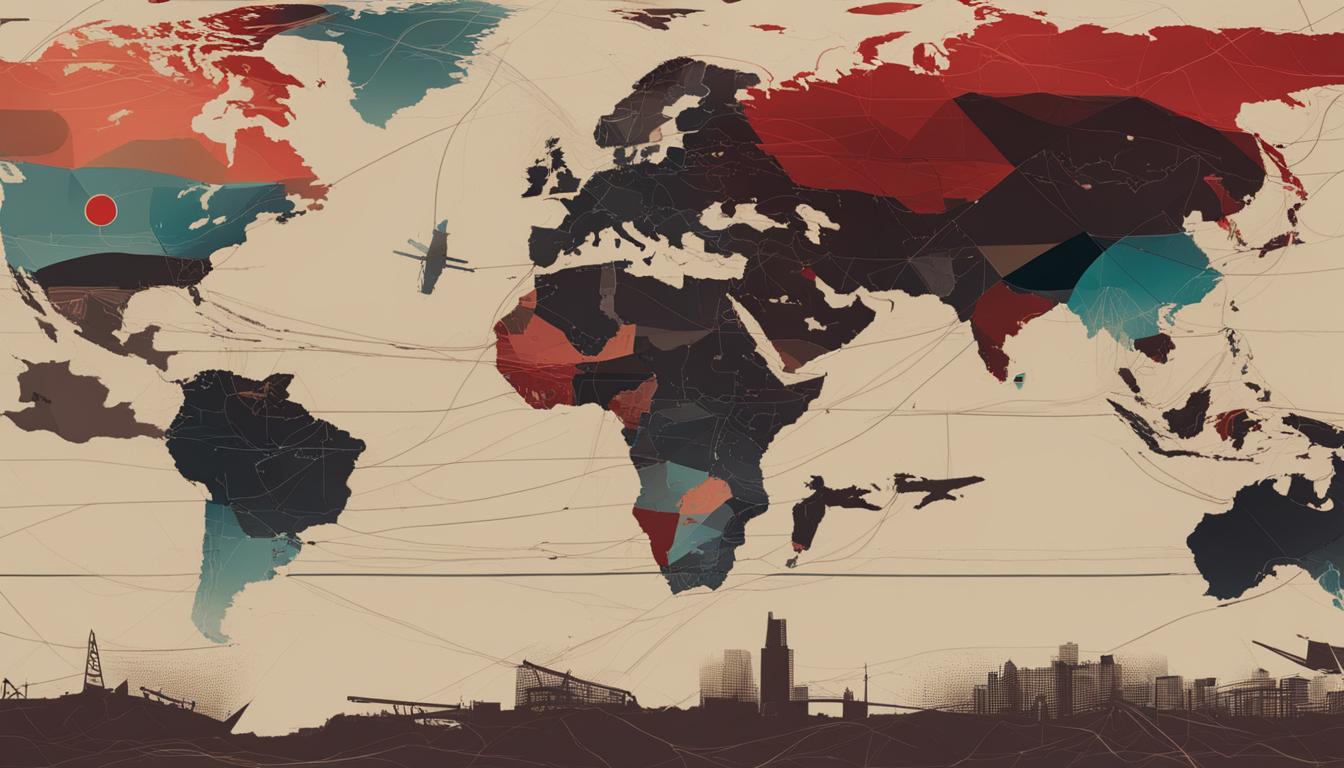World War II, also known as the Second World War, was a global conflict that took place from 1939 to 1945. The principal combatants were the Axis powers (Germany, Italy, and Japan) and the Allies (France, Great Britain, the United States, the Soviet Union, and China). The war was a continuation of unresolved disputes from World War I and the conditions imposed on Germany in the Treaty of Versailles. It resulted in the highest number of deaths in history, with estimates ranging from 50 to 70 million.
Key Takeaways:
- The Second World War, also known as World War II, lasted from 1939 to 1945.
- The Axis powers (Germany, Italy, and Japan) fought against the Allies (France, Great Britain, the United States, the Soviet Union, and China).
- The war was a result of unresolved conflicts from World War I and the harsh conditions imposed on Germany in the Treaty of Versailles.
- The war resulted in the highest number of deaths in history, with estimates ranging from 50 to 70 million.
- The timeline of World War II is filled with major events and battles that shaped the outcome of the war.
- World War II had a profound impact on the world, leading to geopolitical changes and advancements in technology.
Causes of World War II
The origins of World War II can be attributed to several factors that contributed to rising tensions and conflicts in the years leading up to the war. One of the main causes was the aftermath of World War I, particularly the harsh terms imposed on Germany in the Treaty of Versailles. The treaty placed heavy financial burdens on Germany and weakened its economy, leading to resentment and nationalism that ultimately fueled the war.
Another significant factor was the rise of fascist leaders and expansionist ambitions, particularly in Germany and Italy. Adolf Hitler and the Nazi Party sought to regain German territory and establish a dominant Aryan empire, while Benito Mussolini sought to revive the Roman Empire through aggressive military campaigns. These expansionist aims created a volatile climate in Europe, escalating tensions among nations.
Additionally, the failure of appeasement policies by Western powers to address Hitler’s aggressive actions further contributed to the outbreak of war. The invasion of Poland by Germany in 1939 marked the official start of the war in Europe, triggering a series of alliances and counterattacks that engulfed the continent. Furthermore, conflicts were already unfolding in Asia, with Japan engaging in territorial expansion and clashes with neighboring countries, setting the stage for a global conflict.
The Invasion of Poland and the Start of World War II
“I propose that we carry on military operations against Poland with lightning speed. The aim is to destroy her military forces. What we want is to break up Poland’s strength quickly and then proceed calmly.” – Adolf Hitler
The invasion of Poland by Germany in September 1939 is widely regarded as the official start of World War II. Hitler’s aggressive expansionist policies, coupled with the failure of diplomatic negotiations and appeasement attempts, led to the invasion. This act of aggression prompted France and Great Britain to declare war on Germany, officially commencing the war in Europe.
| Year | Events |
|---|---|
| 1939 | Invasion of Poland by Germany – Official start of war in Europe |
| 1940 | Germany invades France and the Low Countries, leading to the fall of France |
| 1941 | Germany invades the Soviet Union; Japan attacks Pearl Harbor, bringing the United States into the war |
The causes of World War II were complex and multifaceted, involving a combination of unresolved issues from World War I, the rise of fascist and expansionist ideologies, and the failure of diplomacy. These factors converged to create a global conflict that would result in widespread devastation and loss of life.
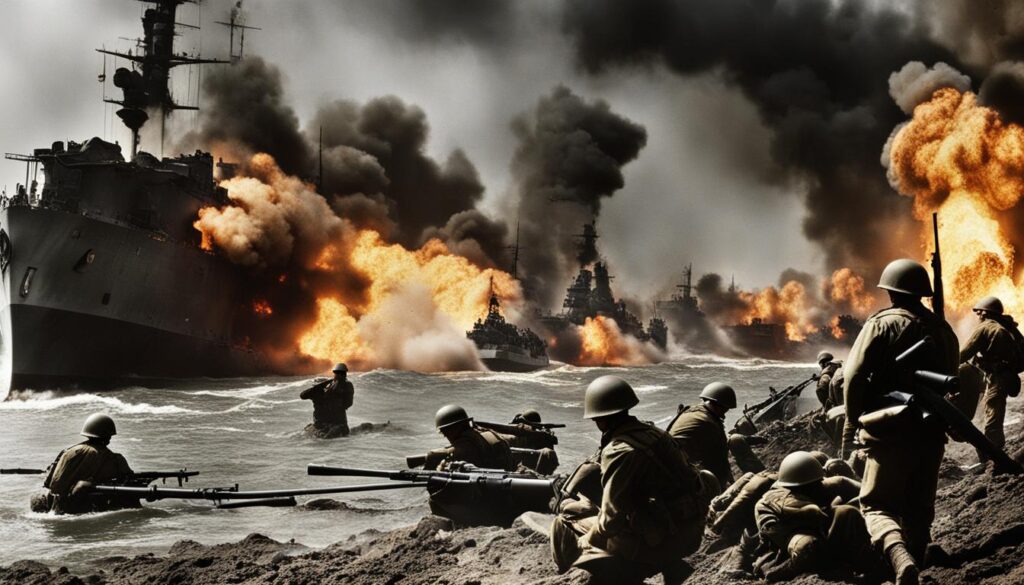
Major Events in Europe
During World War II, Europe witnessed several major events that shaped the course of the war and ultimately led to the defeat of the Axis powers. These events played a crucial role in determining the outcome of the conflict and had a significant impact on the lives of millions of people.
One of the key events in Europe was Hitler’s invasion of Poland in 1939, which marked the official start of the war. This act of aggression triggered the involvement of several European nations, including France and Great Britain, who declared war on Germany in response. The fall of France in 1940 was another significant event that allowed the Nazis to consolidate their control over Western Europe.
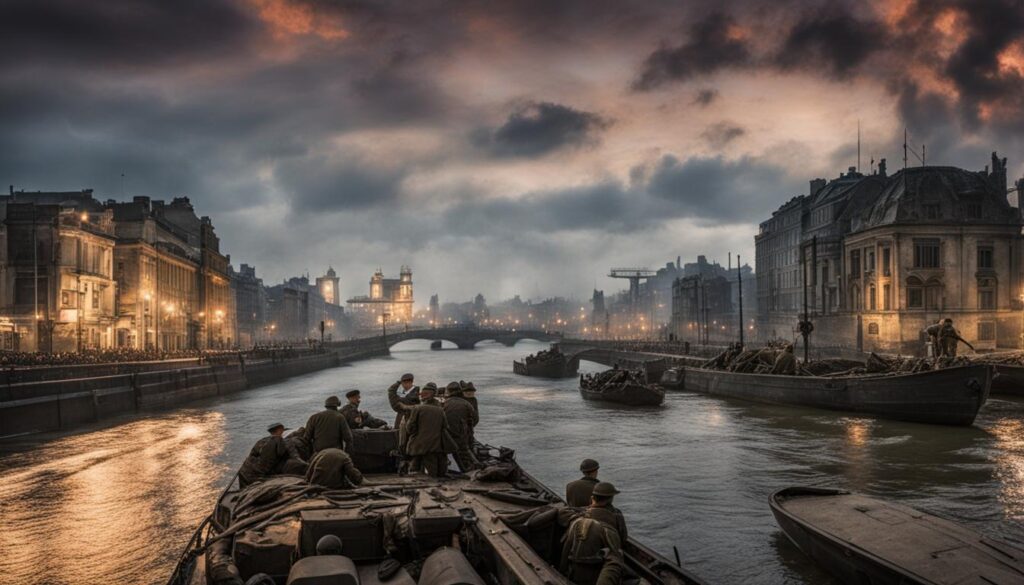
The Battle of Britain in the same year was a major turning point in the war. It was a fierce air campaign between the German Luftwaffe and the British Royal Air Force, fought primarily over British skies. The British successfully defended against the German air attacks, preventing a German invasion and boosting the morale of the Allied forces.
Another pivotal event in Europe was the German invasion of the Soviet Union in 1941. This massive military operation aimed to secure vital resources and eliminate the Soviet Union as a potential threat. The subsequent Battle of Stalingrad, fought between 1942 and 1943, marked a significant turning point in the war. The Soviet victory at Stalingrad not only halted the German advance but also marked the first major defeat for the Wehrmacht.
Other major events in Europe include the D-Day invasion in 1944, when Allied forces launched a massive amphibious assault on the beaches of Normandy, France. This operation, also known as Operation Overlord, was a critical step in liberating Western Europe from Nazi occupation. The Battle of Berlin in 1945, during which Soviet forces captured the German capital, marked the end of the war in Europe and the ultimate defeat of Nazi Germany.
The table below summarizes the major events in Europe during World War II:
| Event | Date |
|---|---|
| Invasion of Poland | September 1, 1939 |
| Fall of France | June 14, 1940 |
| Battle of Britain | July 10, 1940 – October 31, 1940 |
| Invasion of the Soviet Union | June 22, 1941 |
| Battle of Stalingrad | August 23, 1942 – February 2, 1943 |
| D-Day Invasion | June 6, 1944 |
| Battle of Berlin | April 16, 1945 – May 2, 1945 |
Major Events in Asia-Pacific
In the Asia-Pacific theater, World War II was marked by a series of significant events that shaped the outcome of the war. From the initial Sino-Japanese conflict to the devastating bombings of Hiroshima and Nagasaki, the region witnessed intense battles and strategic maneuvers.
Japanese Invasion of Southeast Asia
The Japanese invasion of Southeast Asia began shortly after the attack on Pearl Harbor in 1941. With a series of swift military operations, Japan seized control of countries like Singapore, the Philippines, and Indonesia, expanding its empire across the region. These conquests gave Japan access to valuable resources and further fueled its aggressive ambitions.
Battle of Midway and Pacific Island-Hopping Campaign
The Battle of Midway in 1942 marked a turning point in the Pacific theater. The United States successfully countered Japanese aggression and inflicted significant losses on their naval forces, shifting the balance of power. Following this victory, the US adopted a strategy known as “island-hopping,” aiming to bypass heavily fortified Japanese positions and seize strategic islands in the Pacific. This approach gradually weakened Japan’s defense, paving the way for Allied advances.
Dropping of Atomic Bombs and Japan’s Surrender
The climax of the war in Asia-Pacific came with the dropping of atomic bombs on the Japanese cities of Hiroshima and Nagasaki in August 1945. The bombings caused immense destruction and loss of life and forced Japan to surrender, bringing an end to World War II. The use of atomic weapons in this conflict marked a solemn chapter in human history and forever changed the nature of warfare.
| Event | Date |
|---|---|
| Japanese Invasion of Southeast Asia | 1941-1942 |
| Battle of Midway | 1942 |
| Pacific Island-Hopping Campaign | 1943-1945 |
| Dropping of Atomic Bombs | August 1945 |
| Japan’s Surrender | August 1945 |
These major events in the Asia-Pacific theater had a profound impact on the outcome of World War II and reshaped the region’s geopolitical landscape. The battles and campaigns fought in this theater showcased the determination and sacrifice of both Allied forces and the Axis powers, leaving a lasting legacy in the annals of history.
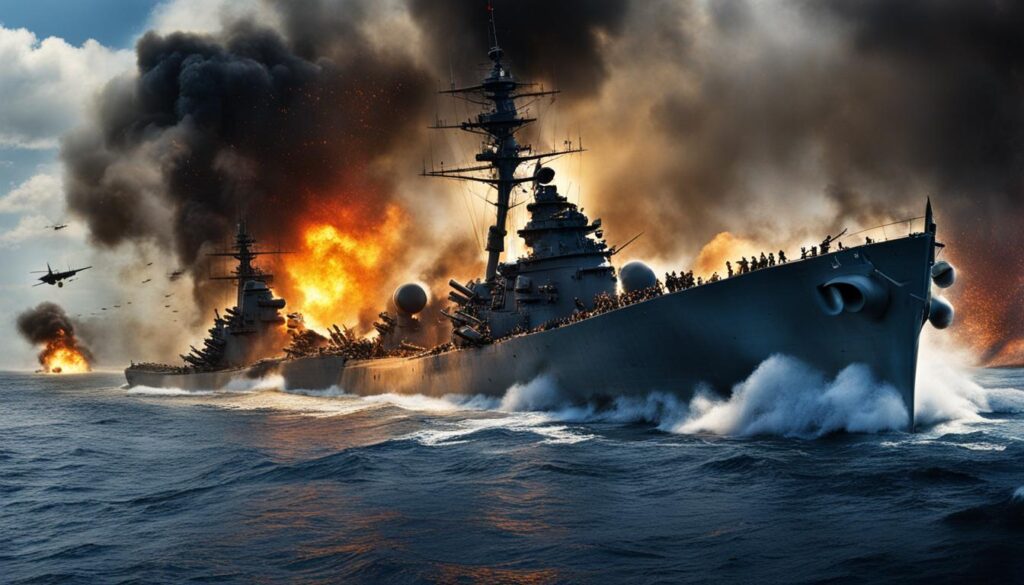
Battle of Britain and the Blitz
The Battle of Britain, a crucial air campaign during World War II, was fought between the German Luftwaffe and the British Royal Air Force. It took place from July to October 1940 and was a pivotal moment in the war. The German objective was to gain air superiority in preparation for a possible invasion of Britain. However, the British RAF successfully defended their skies and prevented the German forces from achieving their goal.
The Battle of Britain is often referred to as a turning point in the war, as it demonstrated that Hitler’s forces could be resisted and defeated. The British resilience and courage in the face of relentless German air attacks played a crucial role in securing victory. Winston Churchill, the British Prime Minister at the time, famously said, “Never in the field of human conflict was so much owed by so many to so few,” highlighting the bravery of the RAF pilots who defended their country.
“Never in the field of human conflict was so much owed by so many to so few.”
The Battle of Britain was followed by a period known as the Blitz, which lasted from September 1940 to May 1941. The Blitz refers to the German bombing campaign against British cities, particularly London. The aim was to break the morale of the British people and force them to surrender. However, despite the heavy bombings and widespread destruction, the British population showed remarkable resilience and unity. They sought shelter in underground stations and tunnels, while firefighters and volunteers worked tirelessly to extinguish fires and provide support to those affected.
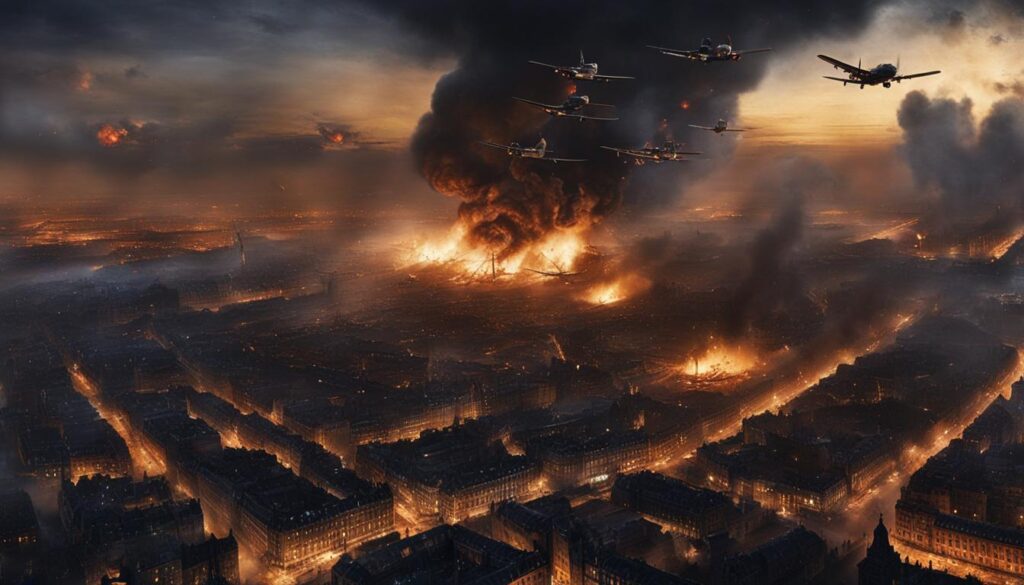
In conclusion, the Battle of Britain and the Blitz were significant events in World War II. The successful defense of Britain against the German Luftwaffe marked a turning point in the war and demonstrated the power of resilience and determination. The bravery and sacrifice of the RAF pilots and the civilian population during the Blitz are a testament to the indomitable spirit of the British people.
Holocaust and Genocide
The Holocaust was one of the most heinous and devastating genocides in human history. During World War II, the Nazis systematically exterminated approximately six million Jews, as well as millions of others, including Romani people, disabled individuals, and political dissidents. The genocide was carried out through mass shootings, forced labor, and most notably, the implementation of extermination camps like Auschwitz, where victims were subjected to inhumane conditions and the horrors of gas chambers.
The Holocaust serves as a stark reminder of the depths of human cruelty and the consequences of unchecked hatred and discrimination. It stands as a testament to the importance of remembering and educating future generations about the atrocities committed during World War II, in order to prevent similar acts of genocide from occurring in the future.
“Never forget” – Elie Wiesel
It is crucial to acknowledge that the Holocaust was not an isolated event during World War II. Other genocides and war crimes also occurred, such as the Nanking Massacre in China and the widespread killings in the Pacific theater. These acts of violence underscore the urgent need for global unity, human rights advocacy, and international cooperation to prevent such atrocities from happening again.
| Type of Victims | Estimated Number |
|---|---|
| Jews | Approximately 6 million |
| Romani people | Approximately 200,000 to 500,000 |
| Disabled individuals | Approximately 200,000 to 250,000 |
| Political dissidents | Approximately 200,000 to 250,000 |
| Others (including homosexuals, Jehovah’s Witnesses, and Soviet POWs) | Approximately 5 million |
Major Battles and Campaigns
World War II was marked by numerous major battles and campaigns that shaped the course of the war and had significant historical implications. From the vast conflicts on the Eastern Front to the decisive battles in the Pacific theater, these engagements tested the strength, strategy, and resilience of the opposing forces.
The Battle of Stalingrad
One of the most iconic and pivotal battles of World War II was the Battle of Stalingrad. Lasting from August 1942 to February 1943, it was a major turning point in the war. The battle was fought between the German Army and the Soviet Union, and it resulted in a decisive Soviet victory. The German forces suffered heavy losses and were forced to retreat, marking the first significant defeat for the German Army in the war.
The Battle of Normandy (D-Day)
The Battle of Normandy, also known as D-Day, was a massive amphibious assault launched by the Allies on June 6, 1944. It was the largest seaborne invasion in history and played a crucial role in the liberation of Western Europe from German occupation. The successful invasion allowed the Allies to establish a foothold in France and ultimately led to the defeat of Germany.
The Pacific Island-Hopping Campaign
The Pacific Island-Hopping Campaign was a series of military operations conducted by the Allies in the Pacific theater. The goal was to capture strategically important Japanese-held islands and establish airfields to support further advances against Japan. This campaign included notable battles such as the Battle of Midway, the Battle of Guadalcanal, and the Battle of Okinawa.
| Battle/Campaign | Date | Location | Sides | Outcome |
|---|---|---|---|---|
| Battle of Stalingrad | August 23, 1942 – February 2, 1943 | Stalingrad, Soviet Union | Soviet Union vs. Germany | Decisive Soviet Victory |
| Battle of Normandy (D-Day) | June 6, 1944 – August 30, 1944 | Normandy, France | Allies vs. Germany | Allied Victory, Liberation of Western Europe |
| Pacific Island-Hopping Campaign | 1943 – 1945 | Pacific Islands | Allies vs. Japan | Allied Victory, Advance towards Japan |
End of World War II
The end of World War II marked a turning point in global history. After years of devastation and loss of life, the war finally came to a close, bringing both relief and the beginning of a long period of recovery. The surrender of Japan and Germany, the last two major Axis powers, signified the formal end of the war and set the stage for a new era of peace and rebuilding.
Germany surrendered on May 7, 1945, following the fall of Berlin to the Allied forces. This event marked the end of Nazi Germany and Adolf Hitler’s reign of terror. The surrender came after years of intense fighting and marked a major victory for the Allies. On September 2, 1945, Japan officially surrendered with the signing of the Japanese Instrument of Surrender aboard the USS Missouri. The bombings of Hiroshima and Nagasaki by the United States had forced Japan’s hand, ending the war in the Pacific.
The end of World War II brought about significant geopolitical changes. The United States and the Soviet Union emerged as the world’s new superpowers, shaping the global balance of power for decades to come. The United Nations was established as an international organization aimed at promoting peace and preventing future conflicts. The war also had profound social and cultural impacts, leading to advancements in science and technology, as well as the recognition of the importance of human rights.
The Surrender of Japan and Germany
“The unconditional surrender of Germany and Japan represented the triumph of the Allied forces and the beginning of a new era of peace. It was a watershed moment in history, marking the end of one of the most devastating conflicts the world had ever seen. The surrender of these two major Axis powers not only brought an end to their aggressive expansionist ambitions but also paved the way for the rebuilding and reconstruction of war-torn nations.”
| Event | Date |
|---|---|
| Germany surrenders | May 7, 1945 |
| Japan surrenders | September 2, 1945 |
Technology and Weapons of World War II
World War II witnessed significant advancements in military technology, as nations raced to develop innovative weapons and tactics to gain an edge on the battlefield. These advancements revolutionized warfare and had a profound impact on the outcome of the war.
Innovations in Aviation
One of the most notable technological developments of World War II was in aviation. The war saw the emergence of powerful fighter planes like the Supermarine Spitfire and the Messerschmitt Bf 109, which played crucial roles in air combat. Bombers, such as the B-17 Flying Fortress and the Lancaster, were used to devastating effect in strategic bombing campaigns. Aircraft carriers also played a significant role in naval warfare, enabling the projection of air power over long distances.
Advancements in Naval Warfare
The use of submarines became a critical component of naval strategies during World War II. Both the Axis and the Allies utilized submarines for reconnaissance, supply transport, and, in some cases, offensive operations. Submarines like the German U-boats and the American Gato-class submarines became feared adversaries in the battle for control of the seas. Additionally, advancements in naval artillery and torpedoes improved the effectiveness of surface ships in combat.
Ground-Based Technology
World War II saw significant advancements in ground-based military technology as well. Tanks played a crucial role in mechanized warfare, with heavy tanks like the German Tiger and the Soviet T-34 becoming formidable weapons on the battlefield. The development of radar and sonar technology enabled better detection of enemy forces and enhanced the accuracy of artillery fire. The use of encrypted communications, such as the German Enigma machine, allowed for secure and covert communication among military personnel.
| Aviation | Naval Warfare | Ground-Based Technology |
|---|---|---|
| 1. Fighter planes (Spitfire, Bf 109) | 1. Submarines (U-boats) | 1. Tanks (Tiger, T-34) |
| 2. Bombers (B-17, Lancaster) | 2. Naval artillery and torpedoes | 2. Radar and sonar technology |
| 3. Aircraft carriers | 3. Advanced naval communications | 3. Encrypted communication (Enigma machine) |
The technological advancements of World War II transformed the nature of warfare and had lasting effects on military strategies and tactics. These innovations paved the way for future advancements in military technology and shaped the world we live in today.
Impact of World War II
The impact of World War II was immense and far-reaching, shaping the course of history for decades to come. The consequences of this global conflict affected not only the nations directly involved but also had significant implications for the entire world.
Social and Cultural Changes
World War II brought about profound social and cultural changes. The war disrupted traditional norms and paved the way for advancements in gender equality. With many men serving in the military, women took on new roles in the workforce and gained greater independence. This shift laid the foundation for the feminist movement that emerged in the post-war years.
Furthermore, the war led to a greater recognition of human rights and the atrocities committed during the Holocaust. The Nuremberg Trials, held after the war, established the principles of international law and accountability for war crimes, setting a precedent for future tribunals.
Scientific and Technological Advancements
World War II sparked significant advancements in science and technology. The development of nuclear weapons, exemplified by the Manhattan Project, forever changed the nature of warfare and had far-reaching implications for global security. This period also witnessed advancements in aviation, with the introduction of jet engines and the use of radar technology.
Scientific research during the war laid the groundwork for various post-war innovations, such as the development of antibiotics and advancements in medical technology. These advancements revolutionized healthcare and improved the quality of life for millions around the world.
Geopolitical Shifts
World War II brought about a tremendous shift in the geopolitical landscape. The war marked the decline of European colonial powers and the rise of new superpowers, namely the United States and the Soviet Union. The conflict propelled the United States to the forefront of global politics and established it as a dominant force in international affairs.
The aftermath of the war also led to the decolonization of many nations, as colonial powers struggled to maintain control over their territories. This shift in power dynamics laid the groundwork for the Cold War and the subsequent division of the world into two ideological blocs.
| Impact of World War II | Consequences |
|---|---|
| Social and Cultural Changes | Advancements in gender equality and recognition of human rights |
| Scientific and Technological Advancements | Development of nuclear weapons and advancements in aviation and medical technology |
| Geopolitical Shifts | Rise of the United States and the Soviet Union as global superpowers, decolonization of many nations |
Overall, the impact of World War II cannot be understated. It ushered in a new era characterized by rapid technological advancements, shifting power dynamics, and a greater emphasis on human rights. The consequences of this global conflict continue to shape our world today.
Conclusion
The comprehensive guide to World War II timeline highlights the key events and significant aspects of this global conflict that took place from 1939 to 1945. The war was a result of unresolved disputes from World War I and the aggression of the Axis powers, namely Germany, Italy, and Japan, against the Allies consisting of France, Great Britain, the United States, the Soviet Union, and China.
World War II was marked by major battles and campaigns in both Europe and the Asia-Pacific region. Notable events include the Battle of Stalingrad, the Battle of Normandy (D-Day), the Second Sino-Japanese War, and the attack on Pearl Harbor. The war also witnessed the Holocaust, a systematic genocide by the Nazis, and other war crimes committed during the conflict.
The war came to an end with the surrender of Japan and Germany, leading to significant geopolitical changes and the establishment of international organizations like the United Nations. World War II had far-reaching consequences, reshaping the world order and driving advancements in technology, science, and human rights laws. Its lessons continue to shape our present and future.
FAQ
What were the causes of World War II?
The causes of World War II included tensions arising from the aftermath of World War I, such as the Treaty of Versailles and the rise of imperialism and nationalism. Hitler and the Nazi Party played a significant role in starting the war through their expansionist ambitions.
When did World War II start and end?
World War II started in 1939 and ended in 1945.
Who were the main combatants in World War II?
The main combatants in World War II were the Axis powers (Germany, Italy, and Japan) and the Allies (France, Great Britain, the United States, the Soviet Union, and China).
What were some major events in Europe during World War II?
Some major events in Europe during World War II include the fall of France in 1940, the Battle of Stalingrad in 1942-1943, the D-Day invasion in 1944, and the Battle of Berlin in 1945.
What were some major events in the Asia-Pacific region during World War II?
Some major events in the Asia-Pacific region during World War II include the Second Sino-Japanese War, the attack on Pearl Harbor, the Japanese invasion of Southeast Asia and the Pacific Islands, and the dropping of atomic bombs on Hiroshima and Nagasaki.
What was the Battle of Britain and the Blitz?
The Battle of Britain was a major air campaign in 1940 between the German Luftwaffe and the British Royal Air Force, which the British successfully defended against German air attacks. The Blitz refers to the German bombing campaign against British cities that followed the Battle of Britain.
What was the Holocaust?
The Holocaust was the systematic genocide of millions of Jews and other persecuted groups by the Nazis during World War II. It involved mass killings in concentration camps and the implementation of policies aimed at exterminating entire populations.
What were some major battles and campaigns in World War II?
Some notable battles and campaigns in World War II include the Battle of Stalingrad, the siege of Leningrad, the Battle of Normandy (D-Day), the Battle of Iwo Jima, and the Battle of Okinawa.
When did World War II officially end?
World War II officially ended on September 2, 1945, with the signing of the Japanese Instrument of Surrender, which followed the bombings of Hiroshima and Nagasaki.
What technological advancements were made during World War II?
During World War II, there were significant advancements in military technology, including radar, Sonar, nuclear weapons, aviation, tanks, submarines, and communication and encryption systems.
What was the impact of World War II?
World War II had a profound impact on the world, reshaping the geopolitical landscape and causing significant social, cultural, and technological changes. It also led to the establishment of new international organizations and highlighted the need for human rights laws.
Source Links
- https://www.historyextra.com/period/second-world-war/timeline-important-dates-ww2-exact/
- https://en.wikipedia.org/wiki/Outline_of_World_War_II
- https://wwiifoundation.org/timeline-of-wwii/
